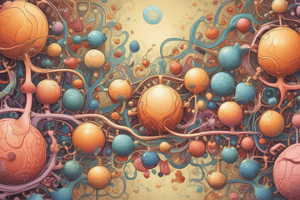Podcast
Questions and Answers
What is broken down into 2 fatty acids and a monoacylglyceride during digestion?
What is broken down into 2 fatty acids and a monoacylglyceride during digestion?
- Cholesterol
- Triglycerides (correct)
- Proteins
- Phospholipids
Where do micelles carry fatty acids to?
Where do micelles carry fatty acids to?
- Gallbladder
- Pancreas
- Liver
- Enterocyte (correct)
What is used to transport LDL into cells?
What is used to transport LDL into cells?
- VLDL
- HDL
- LDL receptor (correct)
- Chylomicrons
Where do medium and short chain fatty acids get transported directly into?
Where do medium and short chain fatty acids get transported directly into?
What carries cholesterol back to the liver?
What carries cholesterol back to the liver?
Where are long chain and very long chain fatty acids resynthesized as triglycerides?
Where are long chain and very long chain fatty acids resynthesized as triglycerides?
What lipoprotein contains the highest proportion of cholesterol?
What lipoprotein contains the highest proportion of cholesterol?
Where are triglycerides transported into on chylomicrons?
Where are triglycerides transported into on chylomicrons?
Where must excess protein and carbohydrate first go?
Where must excess protein and carbohydrate first go?
What is used to carry fatty acids to the enterocyte?
What is used to carry fatty acids to the enterocyte?
Where do chylomicrons transport triglycerides to?
Where do chylomicrons transport triglycerides to?
What lipoprotein carries triglycerides, cholesterol, phospholipids, and proteins?
What lipoprotein carries triglycerides, cholesterol, phospholipids, and proteins?
Which enzyme breaks down VLDLs and chylomicrons, releasing fatty acids for storage as triglycerides in adipose cells?
Which enzyme breaks down VLDLs and chylomicrons, releasing fatty acids for storage as triglycerides in adipose cells?
What is the first energy storage site used when energy is needed?
What is the first energy storage site used when energy is needed?
Which hormone activates Hormone Sensitive Lipase, breaking down triglyceride stores in adipose tissue?
Which hormone activates Hormone Sensitive Lipase, breaking down triglyceride stores in adipose tissue?
What facilitates fatty acid uptake by cells and their entry into mitochondria for beta-oxidation?
What facilitates fatty acid uptake by cells and their entry into mitochondria for beta-oxidation?
What combines with oxaloacetate to enter the citric acid cycle during fatty acid metabolism?
What combines with oxaloacetate to enter the citric acid cycle during fatty acid metabolism?
In what condition are ketone bodies formed during energy metabolism?
In what condition are ketone bodies formed during energy metabolism?
What is the primary function of ketone bodies during energy metabolism?
What is the primary function of ketone bodies during energy metabolism?
Where is excess energy from fat stored via chylomicrons?
Where is excess energy from fat stored via chylomicrons?
What hormones regulate the breakdown of stored triglycerides in adipose tissue?
What hormones regulate the breakdown of stored triglycerides in adipose tissue?
What is the primary site for the breakdown of stored triglycerides when energy intake is insufficient?
What is the primary site for the breakdown of stored triglycerides when energy intake is insufficient?
What is the role of ketone bodies in preventing excessive muscle protein loss during energy deprivation?
What is the role of ketone bodies in preventing excessive muscle protein loss during energy deprivation?
What is the function of Carnitine translocase (CAT) in fatty acid metabolism?
What is the function of Carnitine translocase (CAT) in fatty acid metabolism?
What is the primary function of Acyl-CoA synthetase in fatty acid metabolism?
What is the primary function of Acyl-CoA synthetase in fatty acid metabolism?
What is the role of inner mitochondrial membrane palmitoyl transferase 2 (CPT2) in fatty acid metabolism?
What is the role of inner mitochondrial membrane palmitoyl transferase 2 (CPT2) in fatty acid metabolism?
What is the function of fatty acid transfer proteins (FATPS) in fatty acid metabolism?
What is the function of fatty acid transfer proteins (FATPS) in fatty acid metabolism?
Flashcards are hidden until you start studying
Study Notes
Lipid Metabolism and Energy Utilization
- Triglycerides are produced endogenously and transported in VLDLs to adipose tissue for storage.
- Lipoprotein lipase in blood vessel cells breaks down VLDLs and chylomicrons, releasing fatty acids for storage as triglycerides in adipose cells.
- Lipids from the diet can be immediately utilized for energy or stored in adipose tissue.
- When energy is needed, glycogen stores are used first, then the body turns to adipose tissue for fat stores.
- Glucagon activates Hormone Sensitive Lipase, breaking down triglyceride stores in adipose tissue to release fatty acids and glycerol.
- Fatty acids and glycerol from adipose tissue are transported to cells with mitochondria, where they can be used to produce ATP through beta-oxidation.
- Fatty acid transfer proteins (FATPS) facilitate fatty acid uptake by cells, and carnitine facilitates their entry into mitochondria for beta-oxidation.
- Acetyl-CoA from fatty acids combines with oxaloacetate to enter the citric acid cycle, but ketone bodies are formed in severe energy deprivation or low carbohydrate intake.
- Ketone bodies provide energy to the brain and peripheral tissues, conserve glucose, and prevent excessive muscle protein loss for gluconeogenesis.
- Excess energy from fat is stored in adipose tissue via chylomicrons, while excess protein and carbohydrates must first be converted to triglycerides in the liver.
- When energy intake is insufficient, stored triglycerides in adipose tissue are broken down by hormone-sensitive lipase, releasing fatty acids and glycerol into the bloodstream.
- Hormones such as epinephrine, norepinephrine, glucagon, and adrenocorticotropic hormone regulate the breakdown of stored triglycerides in adipose tissue.
Studying That Suits You
Use AI to generate personalized quizzes and flashcards to suit your learning preferences.




